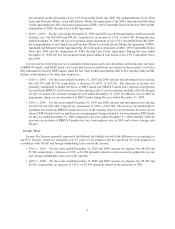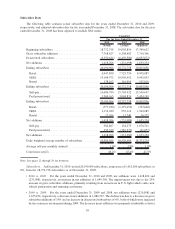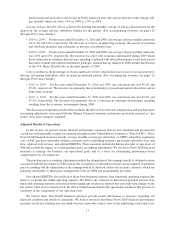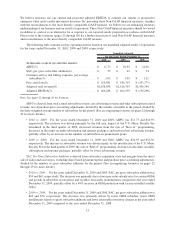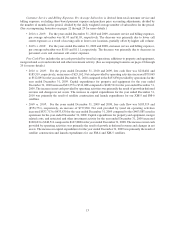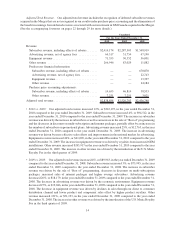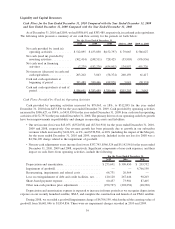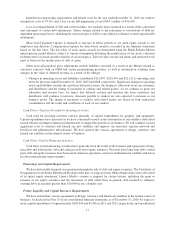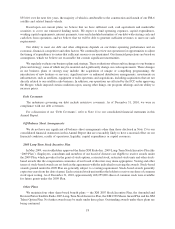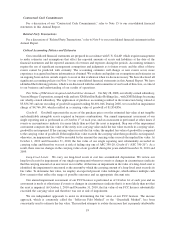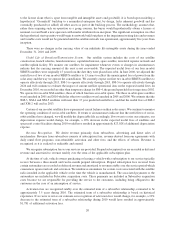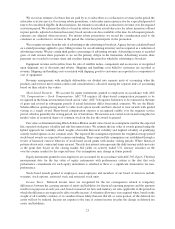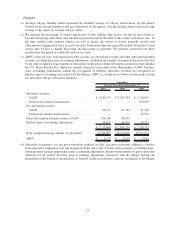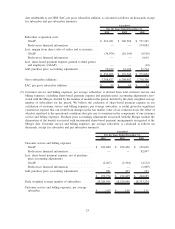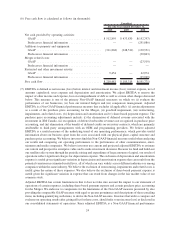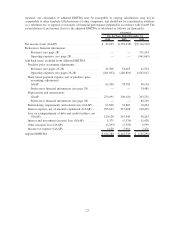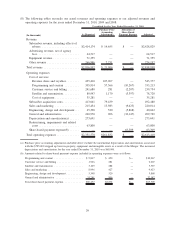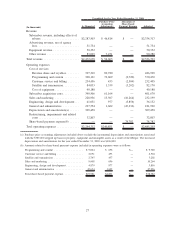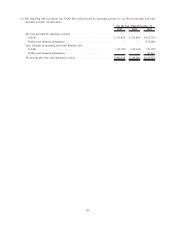XM Radio 2010 Annual Report Download - page 75
Download and view the complete annual report
Please find page 75 of the 2010 XM Radio annual report below. You can navigate through the pages in the report by either clicking on the pages listed below, or by using the keyword search tool below to find specific information within the annual report.Contractual Cash Commitments
For a discussion of our “Contractual Cash Commitments,” refer to Note 15 to our consolidated financial
statements in this Annual Report.
Related Party Transactions
For a discussion of “Related Party Transactions,” refer to Note 9 to our consolidated financial statements in this
Annual Report.
Critical Accounting Policies and Estimates
Our consolidated financial statements are prepared in accordance with U.S. GAAP, which require management
to make estimates and assumptions that affect the reported amounts of assets and liabilities at the date of the
financial statements and the reported amounts of revenues and expenses during the periods. Accounting estimates
require the use of significant management assumptions and judgments as to future events, and the effect of those
events cannot be predicted with certainty. The accounting estimates will change as new events occur, more
experience is acquired and more information is obtained. We evaluate and update our assumptions and estimates on
an ongoing basis and use outside experts to assist in that evaluation when we deem necessary. We have disclosed all
significant accounting policies in Note 3 to our consolidated financial statements in this Annual Report. We have
identified the following policies, which were discussed with the audit committee of our board of directors, as critical
to our business and understanding of our results of operations.
Fair Value of XM Assets Acquired and Liabilities Assumed. On July 28, 2008, our wholly-owned subsidiary,
Vernon Merger Corporation, merged with and into XM Satellite Radio Holdings Inc., with XM Holdings becoming
our wholly-owned subsidiary. The application of purchase accounting resulted in the transaction being valued at
$5,836,363 and our recording of goodwill acquired totaling $6,601,046. During 2008, we recorded an impairment
charge of $4,766,190, which resulted in a carrying value of goodwill of $1,834,856.
Goodwill. Goodwill represents the excess of the purchase price over the estimated fair value of net tangible
and identifiable intangible assets acquired in business combinations. Our annual impairment assessment of our
single reporting unit is performed as of October 1
st
of each year, and an assessment is performed at other times if
events or circumstances indicate it is more likely than not that the asset is impaired. Step one of the impairment
assessment compares the fair value of the entity to its carrying value and if the fair value exceeds its carrying value,
goodwill is not impaired. If the carrying value exceeds the fair value, the implied fair value of goodwill is compared
to the carrying value of goodwill. If the implied fair value exceeds the carrying value then goodwill is not impaired;
otherwise, an impairment loss will be recorded by the amount the carrying value exceeds the implied fair value. At
October 1, 2010 and December 31, 2010, the fair value of our single reporting unit substantially exceeded its
carrying value and therefore was not at risk of failing step one of ASC 350-20, Goodwill (“ASC 350-20”). As a
result, there were no changes in the carrying value of our goodwill during the years ended December 31, 2010 and
2009.
Long-Lived Assets. We carry our long-lived assets at cost less accumulated depreciation. We review our
long-lived assets for impairment of our single reporting unit whenever events or changes in circumstances indicate
that the carrying amount of an asset is not recoverable. At the time an impairment in the value of a long-lived asset is
identified, the impairment is measured as the amount by which the carrying amount of a long-lived asset exceeds its
fair value. To determine fair value, we employ an expected present value technique, which utilizes multiple cash
flow scenarios that reflect the range of possible outcomes and an appropriate discount rate.
Our annual impairment assessment of our FCC licenses is performed as of October 1st of each year and an
assessment is made at other times if events or changes in circumstances indicate that it is more likely than not that
the asset is impaired. At October 1, 2010 and December 31, 2010, the fair value of our FCC licenses substantially
exceeded the carrying value and therefore was not at risk of impairment.
We use independent appraisals to assist in determining the fair value of our FCC licenses. The income
approach, which is commonly called the “Jefferson Pilot Method” or the “Greenfield Method”, has been
consistently used to estimate the fair value. This method attempts to isolate the income that is properly attributable
19


